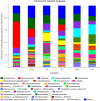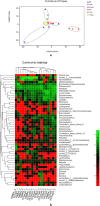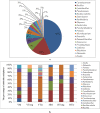Diversity of culture-independent bacteria and antimicrobial activity of culturable endophytic bacteria isolated from different Dendrobium stems
- PMID: 31316117
- PMCID: PMC6637234
- DOI: 10.1038/s41598-019-46863-9
Diversity of culture-independent bacteria and antimicrobial activity of culturable endophytic bacteria isolated from different Dendrobium stems
Abstract
Dendrobium is known for its pharmacological actions including anti-cancer effect, anti-fatigue effect, gastric ulcer protective effect, and so on. At present, only studies on endophytic fungi of Dendrobium affecting the metabolites of host plants have been reported, very little research has been done on endophytic bacteria. In this study, we have demonstrated the great diversity of endophytic bacteria in 6 Dendrobium samples from different origins and cultivars. According to the results of the culture-independent method, the endophytic bacterial community in Dendrobium stems showed obvious different in the 6 samples and was influenced by origin and cultivar. Some bacteria including Ralstonia, Comamonas and Lelliottia were first detected in Dendrobium in this study. Based on the culture-dependent method, a total of 165 cultivable endophytic bacteria isolates were isolated from the sterilized Dendrobium stems, and were classified into 43 species according to the 16S rRNA gene sequence analysis. Moreover, 14 of the 43 strains showed antimicrobial activity against phytopathogen using the Kirby-Bauer method. Strain NA-HTong-7 (Bacillus megaterium, 99.12%) showed the highest antimicrobial activity. This study was the first comprehensive study on endophytic bacteria of Dendrobium from different origins and cultivars, which provides new insights into the endophytic bacteria from Dendrobium.
Conflict of interest statement
The authors declare no competing interests.
Figures





References
-
- Zeng, S. J. Species introduction of Dendrobium officinale in China. J. Flowers. 19–26 (2015).
-
- Wu YQ, Si JP. Industrial status and sustainable development of Dendrobium officinale. J. China J Chin Mater Med. 2010;35(15):2033–2037. - PubMed
-
- Zhang M, Liu HY. Development status and prospect of Dendrobium officinale industry. J. Modern Chinese Medicine. 2010;12(10):8–11.
-
- Chinese Pharmacopoeia Commission. Chinese Pharmacopoeia, vol. 1, Chinese Medical Science and Technology Press (2015).
Publication types
MeSH terms
Substances
LinkOut - more resources
Full Text Sources
Other Literature Sources

